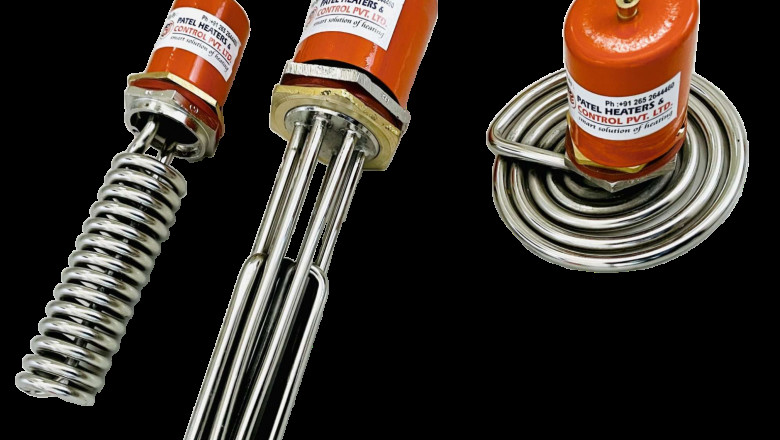views
Water immersion heaters heat fluids in a tank or container to a certain temperature quickly and effectively. There are several types of immersion heaters available on the market. Immersion water heaters are installed by fastening the device to a welded flange that connects to either the tank or the container's nozzle. Screw plug immersion water heaters are placed by screwing them into a threaded aperture of a vessel, container, or tank.
These immersion heaters come in various sizes and functions. They are adaptable and able to be employed in a wide range of applications and procedures where the temperature of oils, solutions, heat transfer fluids, and other liquids must be controlled. Industrial immersion heaters are widely used in a variety of industries, including food and agriculture, chemical applications, and others.
How Do Water Immersion Heaters Work?
A gas heated water tank has a burner beneath that helps to heat the water. In contrast, an immersion heater warms the water immediately inside it. A heating element is immersed in the water, and a powerful electric current flows through it, heating the water in contact with it. Compare it to your standard kitchen kettle but on a bigger and slightly more sophisticated scale. The tank contains a thermostat, which helps to keep the water at a specified temperature.
Essentially, you get heated water out of the tank when the influx of cold water from beneath the reservoir pushes the hot water out from the top of the tank with enough pressure to force it out of the cylinder. When hot water is heated, as in this example by the immersion element, it rises to the surface.
The water immersion heater wiring will frequently incorporate an isolating switch where it connects to the main electrical supply. While natural gas heaters are less costly, immersion heaters require less ventilation. However, attaching a timer to the tank will save money. This means that water may be heated and kept warm in the insulated tank until needed.
Who needs a water immersion heater?
Many residences utilize a central combined heating/hot water boiler to provide both warmth and hot water. Some homes may include an immersion heater as a backup. However, it is not unusual to discover some flats that do not have a gas supply and rely solely on immersion heaters for hot water.
Here are the advantages of water immersion heaters:
- The thermostatic control of an immersion heater ensures that the temperature of the water remains consistent by automatically turning on and off the heater as needed.
- Immersion heaters, unlike central heating systems, are not connected to a boiler, allowing you to take a hot shower even if your boiler fails.
- A well-insulated immersion heater may keep water heated for several hours after it has been switched off.
- You may schedule the immersion heater to heat water during favorable off-peak hours when energy costs are lower.
- Immersion heaters are quite simple to operate and use. They often simply require you to turn off and on a switch and adjust the thermostat.
What are some safety tips for using a water immersion heater?
When operating electrical appliances, particularly those that interact with water, always prioritize safety. Let's look at the thorough safety precautions that every immersion water heater user should follow.
-
Essential Pre-Use Safety Checks
Before you plug in your immersion water heater rod, take time to do important safety inspections. Begin by checking the power cord for signs of wear and damage. The insulation should be intact along its length, and the plug should be free of fractures and burns. This is especially crucial for 1000-watt immersion rods, which are used on a daily basis.
When utilizing a water immersion heater, the container you choose is very important. Always use a non-metallic container, ideally made of high-quality plastic or rubber. The container should be deep enough to completely submerge the heating element while leaving a safe clearance from the bottom. To guarantee maximum safety when using an immersion rod water heater in India, keep the container sturdy and position it on a dry, flat surface.
2. Safe Operating Practices
Critical operational safety procedures include:
- Never leave the gadget unattended.
- Maintaining the water level within designated boundaries.
- Keeping youngsters and pets out of the heating area.
- Monitor for any odd noises or odors.
- Avoid contact with the container when heating.
When using your water immersion heater, time and attention are essential. This is especially crucial with higher-powered immersion rod 1500-watt versions, which heat water faster and may cause overheating if left unattended.
3. Daily Care Routines
The durability of your immersion water heater rod begins with everyday maintenance. After each usage, after the device has completely cooled, clean the heating element with a soft, dry cloth to remove any mineral deposits. Pay specific attention to the junction where the rod joins the handle, which can gather moisture over time.
Checking for mineral accumulation is especially crucial for immersion rod water heaters in India, where water hardness varies greatly by location. If you see white or gray scaling on your 1000-watt immersion rod, it's time for a complete cleaning.
4. Deep cleaning and descaling of immersion rods
- Make a solution of equal parts water and white vinegar.
- Soak the heating element for thirty minutes.
- Gently scrub any leftover residues.
- Rinse completely in clean water.
- Dry fully before the next usage.
Conclusion
A water immersion heater is more than simply a method of heating water; it is an investment in your everyday comfort and convenience. By following these detailed rules for safety, maintenance, and efficient operation, you can guarantee that your gadget delivers dependable service for many years to come.






















Comments
0 comment